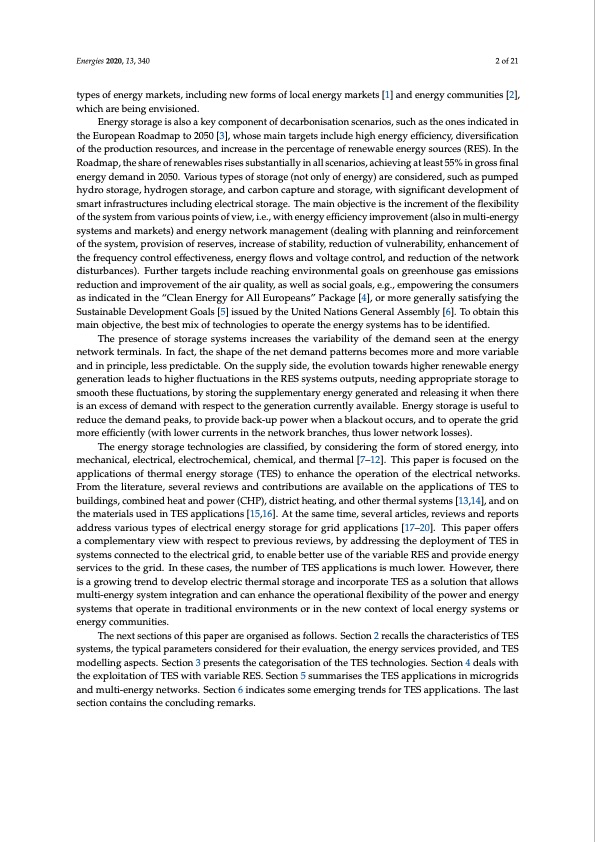
PDF Publication Title:
Text from PDF Page: 002
Energies 2020, 13, 340 2 of 21 types of energy markets, including new forms of local energy markets [1] and energy communities [2], which are being envisioned. Energy storage is also a key component of decarbonisation scenarios, such as the ones indicated in the European Roadmap to 2050 [3], whose main targets include high energy efficiency, diversification of the production resources, and increase in the percentage of renewable energy sources (RES). In the Roadmap, the share of renewables rises substantially in all scenarios, achieving at least 55% in gross final energy demand in 2050. Various types of storage (not only of energy) are considered, such as pumped hydro storage, hydrogen storage, and carbon capture and storage, with significant development of smart infrastructures including electrical storage. The main objective is the increment of the flexibility of the system from various points of view, i.e., with energy efficiency improvement (also in multi-energy systems and markets) and energy network management (dealing with planning and reinforcement of the system, provision of reserves, increase of stability, reduction of vulnerability, enhancement of the frequency control effectiveness, energy flows and voltage control, and reduction of the network disturbances). Further targets include reaching environmental goals on greenhouse gas emissions reduction and improvement of the air quality, as well as social goals, e.g., empowering the consumers as indicated in the “Clean Energy for All Europeans” Package [4], or more generally satisfying the Sustainable Development Goals [5] issued by the United Nations General Assembly [6]. To obtain this main objective, the best mix of technologies to operate the energy systems has to be identified. The presence of storage systems increases the variability of the demand seen at the energy network terminals. In fact, the shape of the net demand patterns becomes more and more variable and in principle, less predictable. On the supply side, the evolution towards higher renewable energy generation leads to higher fluctuations in the RES systems outputs, needing appropriate storage to smooth these fluctuations, by storing the supplementary energy generated and releasing it when there is an excess of demand with respect to the generation currently available. Energy storage is useful to reduce the demand peaks, to provide back-up power when a blackout occurs, and to operate the grid more efficiently (with lower currents in the network branches, thus lower network losses). The energy storage technologies are classified, by considering the form of stored energy, into mechanical, electrical, electrochemical, chemical, and thermal [7–12]. This paper is focused on the applications of thermal energy storage (TES) to enhance the operation of the electrical networks. From the literature, several reviews and contributions are available on the applications of TES to buildings, combined heat and power (CHP), district heating, and other thermal systems [13,14], and on the materials used in TES applications [15,16]. At the same time, several articles, reviews and reports address various types of electrical energy storage for grid applications [17–20]. This paper offers a complementary view with respect to previous reviews, by addressing the deployment of TES in systems connected to the electrical grid, to enable better use of the variable RES and provide energy services to the grid. In these cases, the number of TES applications is much lower. However, there is a growing trend to develop electric thermal storage and incorporate TES as a solution that allows multi-energy system integration and can enhance the operational flexibility of the power and energy systems that operate in traditional environments or in the new context of local energy systems or energy communities. The next sections of this paper are organised as follows. Section 2 recalls the characteristics of TES systems, the typical parameters considered for their evaluation, the energy services provided, and TES modelling aspects. Section 3 presents the categorisation of the TES technologies. Section 4 deals with the exploitation of TES with variable RES. Section 5 summarises the TES applications in microgrids and multi-energy networks. Section 6 indicates some emerging trends for TES applications. The last section contains the concluding remarks.PDF Image | Thermal Energy Storage for Grid Applications

PDF Search Title:
Thermal Energy Storage for Grid ApplicationsOriginal File Name Searched:
energies-13-00340.pdfDIY PDF Search: Google It | Yahoo | Bing
Turbine and System Plans CAD CAM: Special for this month, any plans are $10,000 for complete Cad/Cam blueprints. License is for one build. Try before you buy a production license. More Info
Waste Heat Power Technology: Organic Rankine Cycle uses waste heat to make electricity, shaft horsepower and cooling. More Info
All Turbine and System Products: Infinity Turbine ORD systems, turbine generator sets, build plans and more to use your waste heat from 30C to 100C. More Info
CO2 Phase Change Demonstrator: CO2 goes supercritical at 30 C. This is a experimental platform which you can use to demonstrate phase change with low heat. Includes integration area for small CO2 turbine, static generator, and more. This can also be used for a GTL Gas to Liquids experimental platform. More Info
Introducing the Infinity Turbine Products Infinity Turbine develops and builds systems for making power from waste heat. It also is working on innovative strategies for storing, making, and deploying energy. More Info
Need Strategy? Use our Consulting and analyst services Infinity Turbine LLC is pleased to announce its consulting and analyst services. We have worked in the renewable energy industry as a researcher, developing sales and markets, along with may inventions and innovations. More Info
Made in USA with Global Energy Millennial Web Engine These pages were made with the Global Energy Web PDF Engine using Filemaker (Claris) software.
Sand Battery Sand and Paraffin for TES Thermo Energy Storage More Info
| CONTACT TEL: 608-238-6001 Email: greg@infinityturbine.com | RSS | AMP |